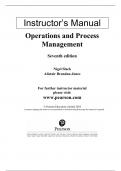Instructor’s Manual
Operations and Process
Management
Seventh edition
Nigel Slack
Alistair Brandon-Jones
For further instructor material
please visit:
www.pearson.com
Pearson Education Limited 2024
Lecturers adopting the main text are permitted to download and photocopy the manual as required.
,PEARSON EDUCATION LIMITED
KAO Two
KAO Park
Harlow CM17 9NA
United Kingdom
Tel: +44 (0)1279 623623
Web: www.pearson.com
-----------------------------------
Fourth edition published 2016
Fifth edition published 2018
Sixth edition published 2021
This edition published 2024
© 2024 Pearson Education Limited. All Rights Reserved
The rights of Nigel Slack and Alistair Brandon-Jones to be identified as authors of this work have
been asserted by them in accordance with the Copyright, Designs and Patents Act 1988.
Pearson Education is not responsible for the content of third-party internet sites.
All rights reserved. Permission is hereby given for the material in this publication to be reproduced
for student handouts, without express permission of the Publishers, for educational purposes only.
In all other cases, no part of this publication may be reproduced, stored in a retrieval system, or
transmitted in any form or by any means, electronic, mechanical, photocopying, recording, or
otherwise without either the prior written permission of the Publishers or a licence permitting
restricted copying in the United Kingdom issued by the Copyright Licensing Agency Ltd.,
Barnard’s Inn, 86 Fetter Lane, London EC4A 1EN. This book may not be lent, resold, hired out or
otherwise disposed of by way of trade in any form of binding or cover other than that in which it is
published, without the prior consent of the Publishers.
, Contents
Chapter 1 Operations and process management 8
Chapter 2 Operations and strategic impact 15
Chapter 3 Product and service innovation 28
Chapter 4 Operations scope and structure 36
Chapter 5 Process design 1 – Positioning 42
Chapter 6 Process design 2 – Analysis 51
Chapter 7 Supply chain management 62
Chapter 8 Capacity management 78
Chapter 9 Inventory management 87
Chapter 10 Resource planning and control 99
Chapter 11 Improvement 107
Chapter 12 Lean operations 113
Chapter 13 Quality management 119
Chapter 14 Risk and resilience 127
Chapter 15 Project management 133
While we work hard to present unbiased, fully accessible content, we want to hear from you about
any concerns or needs with this Pearson product so that we can investigate and address them:
• Please contact us with concerns about any potential bias at
https://www.pearson.com/report-bias.html
• For accessibility-related issues, such as using assistive technology with Pearson products,
alternative text requests, or accessibility documentation, email the Pearson Disability
Support team at disability.support@pearson.com
3
© 2024 Pearson Education Limited. All Rights Reserved.
, Teaching Guides for Operations and Process
Management, 7th Edition
© 2024 Slack, Brandon-Jones and Burgess
The instructors’ manual for this edition of Operations and Process Management is a little different
to those for previous editions. As well as generally updating the manual to reflect the changes we
have made to the content and (especially) the examples and cases in the text, we have made two
particularly significant changes.
Responsible operations
The first is the introduction of a new (to this book) feature in each chapter – ‘Responsible
operations’. This summarises how the topic covered in the chapter touches upon one or more
important social, ethical and environmental issues. To help make use of these features, we have
included in some of the chapters’ teaching notes suggestions of how the feature might be used in a
class setting.
First, however, it is helpful to establish exactly why a responsible operations perspective is being
taken. There are several reasons.
• Responsible issues are clearly important and urgent.
• Operations practice directly impacts responsible performance.
• And, vice versa, responsibility impacts what is operationally acceptable.
• Investors are taking increasing notice of responsible performance through ESG
(environmental, societal and governance) investment criteria.
• Our students are increasingly committed to responsible performance.
Not every chapter’s teaching note has a ‘Responsible operations’ exercise, but there are enough of
them to give an idea of how we use exercises of this type. When using this type of exercise,
remember that many ‘responsible operations’ issues do not have a definitively ‘correct’ answer as
such – they are often there to provoke discussion. The key issue is to establish the relationship
between the topic of the chapter and responsible practice.
In treating the relationship between operations practice and responsibility, one must decide how
much weight to give the topic. Discussing this with educators, there seem to be two ‘extremes’,
with most falling somewhere in between. At one extreme is a response to this question from one
colleague, I always start my course with an Ocean scientist talking about the reality of global
warming. It sensitizes students to environmental issues, at the other extreme is a response of, No, I
try not to get into all that [sustainability]. It only detracts from ‘core’ OM issues and techniques.
4
© 2024 Pearson Education Limited. All Rights Reserved.




